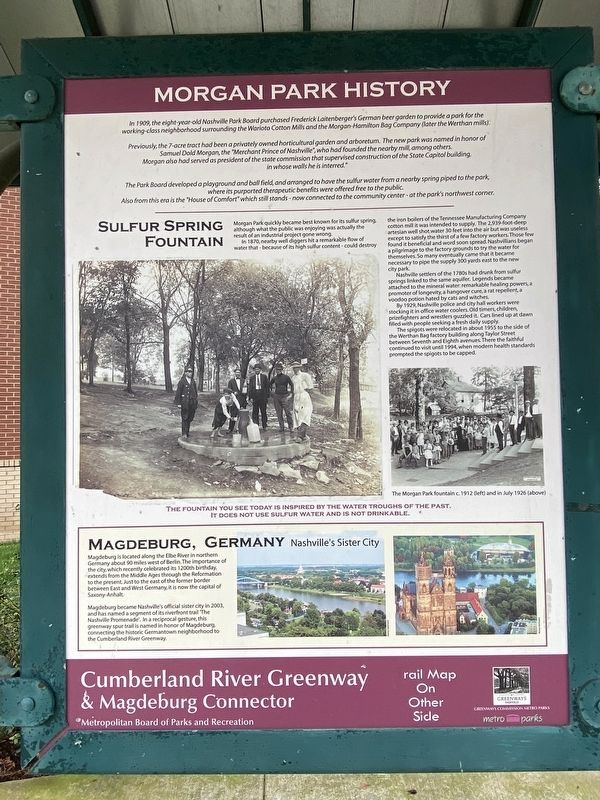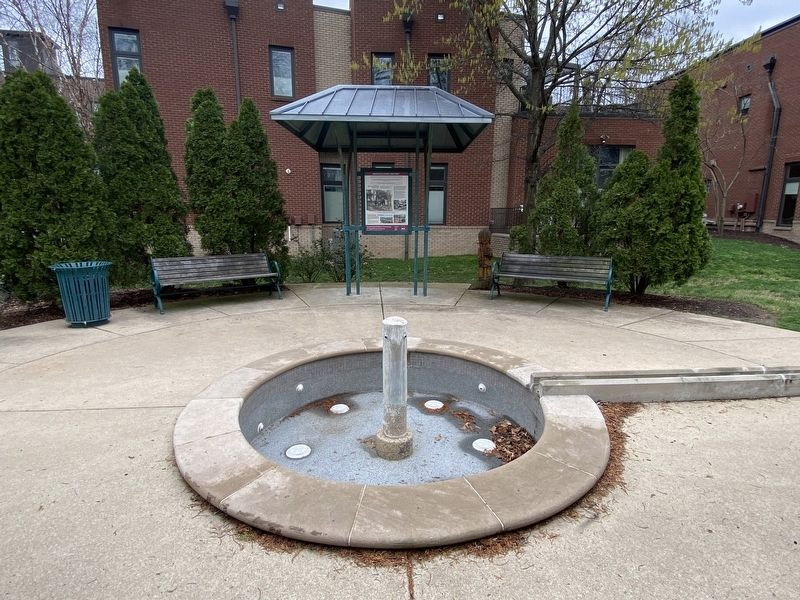Germantown in Nashville in Davidson County, Tennessee — The American South (East South Central)
Morgan Park History
In 1909, the eight-year-old Nashville Park Board purchased Frederick Laitenberger's German beer garden to provide a park for the working-class neighborhood surrounding the Warioto Cotton Mills and the Morgan-Hamilton Bag Company (later the Werthan mills).
Previously, the 7-acre tract had been a privately owned horticultural garden and arboretum. The new park was named in honor of Samuel Dold Morgan, the "Merchant Prince of Nashville", who had founded the nearby mill, among others. Morgan also had served as president of the state commission that supervised construction of the State Capitol building, in whose walls he is interred."
The Park Board developed a playground and ball field, and arranged to have the sulfur water from a nearby spring piped to the park, where its purported therapeutic benefits were offered free to the public. Also from this era is the "House of Comfort" which still stands - now connected to the community center - at the park's northwest corner.
Sulfur Spring Fountain
Morgan Park quickly became best known for its sulfur spring, although what the public was enjoying was actually the result of an industrial project gone wrong. In 1870, nearby well diggers hit a remarkable flow of water that because of its high sulfur content - could destroy the iron boilers of the Tennessee Manufacturing Company cotton mill it was intended to supply. The 2,939-foot-deep artesian well shot water 30 feet into the air but was useless except to satisfy the thirst of a few factory workers. Those few found it beneficial and word soon spread. Nashvillians began a pilgrimage to the factory grounds to try the water for themselves. So many eventually came that it became necessary to pipe the supply 300 yards east to the new city park.
Nashville settlers of the 1780s had drunk from sulfur springs linked to the same aquifer. Legends became attached to the mineral water: remarkable healing powers, a promoter of longevity, a hangover cure, a rat repellent, a voodoo potion hated by cats and witches.
By 1929, Nashville police and city hall workers were stocking it in office water coolers. Old timers, children, prizefighters and wrestlers guzzled it. Cars lined up at dawn filled with people seeking a fresh daily supply.
The spigots were relocated in about 1955 to the side of the Werthan Bag factory building along Taylor Street between Seventh and Eighth avenues. There the faithful continued to visit until 1994, when modern health standards prompted the spigots to be capped.
The fountain you see today is inspired by the water troughs of the past. It does not use sulfur water and is not drinkable.
Magdeburg, Germany - Nashville's Sister City
Magdeburg is located along the Elbe River in northern Germany about 90 miles west of Berlin. The importance of the city, which recently celebrated its 1200th birthday, extends from the Middle Ages through the Reformation to the present. Just to the east of the former border between East and West Germany, it is now the capital of Saxony-Anhalt.
Magdeburg became Nashville's official sister city in 2003, and has named a segment of its riverfront trail 'The Nashville Promenade'. In a reciprocal gesture, this greenway spur trail is named in honor of Magdeburg, connecting the historic Germantown neighborhood to the Cumberland River Greenway.
Erected by Metropolitan Board of Parks and Recreation.
Topics. This historical marker is listed in this topic list: Notable Places.
Location. 36° 10.788′ N, 86° 47.418′ W. Marker is in Nashville, Tennessee, in Davidson County. It is in Germantown. Marker can be reached from the intersection of 5th Avenue North and Hume Street. Touch for map. Marker is in this post office area: Nashville TN 37208, United States of America. Touch for directions.
Other nearby markers. At least 8 other markers are within walking distance of this marker. Fountain of Youth (within shouting distance of this marker); Fehr School (approx. 0.2 miles away); Ratterman Row (approx. ¼ mile away); Centenary Methodist Institute (approx. ¼ mile away); Freeland's Station (approx. ¼ mile away); Germantown (approx. 0.3 miles away); Assumption Church / Cardinal Stritch (approx. 0.3 miles away); George & Nathan “Nearest” Green & Jack Daniels (approx. 0.3 miles away). Touch for a list and map of all markers in Nashville.
Credits. This page was last revised on March 19, 2024. It was originally submitted on March 10, 2024, by Darren Jefferson Clay of Duluth, Georgia. This page has been viewed 61 times since then. Photos: 1, 2. submitted on March 10, 2024, by Darren Jefferson Clay of Duluth, Georgia. • James Hulse was the editor who published this page.

